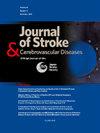Early CSF inflammatory markers after aneurysmal subarachnoid hemorrhage and their relationship to disease severity and shunt placement
IF 1.8
4区 医学
Q3 NEUROSCIENCES
Journal of Stroke & Cerebrovascular Diseases
Pub Date : 2025-07-08
DOI:10.1016/j.jstrokecerebrovasdis.2025.108395
引用次数: 0
Abstract
Background
The inflammatory response within the central nervous system is a key driver of secondary brain injury after aneurysmal subarachnoid hemorrhage (aSAH). Less is known about the impact that inflammation has on complications like persistent post-hemorrhagic hydrocephalus. To explore the association between inflammation, disease severity, and permanent shunt placement, we characterized the early cytokine profiles of the blood and cerebrospinal fluid (CSF) of patients with aSAH.
Methods
Biological samples were collected from aSAH patients admitted to a single-center Neurosciences Intensive Care Unit between 2014 and 2024. Control CSF samples were collected from patients undergoing permanent shunt placement for normal pressure hydrocephalus. A multiplex bead-based immunoassay was used to analyze a panel of cytokines in plasma and CSF samples. Clinical variables, including demographics, disease severity, and permanent shunt placement were collected.
Results
Plasma and/or CSF samples were collected from 83 patients (58 aSAH patients, 25 controls). In aSAH patients, C![]() C motif chemokine ligand-2 (CCL2), interleukin-6 (IL-6), granulocyte-colony stimulating factor (G-CSF), interleukin-8 (IL-8), and vascular endothelial growth factor (VEGF) were all elevated in CSF compared to plasma (p < 0.05 for all comparisons) and in the CSF of aSAH patients as compared to controls (p < 0.001 for all comparisons). However, only G-CSF and VEGF were associated with clinical severity at presentation when considering Hunt and Hess score as a dichotomized variable (p = 0.026 and p = 0.043, respectively). In multivariable models adjusted for age, sex, and modified Fisher Scale score, early CSF concentrations of IL-6 and IL-8 were associated with increased need for permanent shunt placement (p = 0.030 and p = 0.040, respectively).
C motif chemokine ligand-2 (CCL2), interleukin-6 (IL-6), granulocyte-colony stimulating factor (G-CSF), interleukin-8 (IL-8), and vascular endothelial growth factor (VEGF) were all elevated in CSF compared to plasma (p < 0.05 for all comparisons) and in the CSF of aSAH patients as compared to controls (p < 0.001 for all comparisons). However, only G-CSF and VEGF were associated with clinical severity at presentation when considering Hunt and Hess score as a dichotomized variable (p = 0.026 and p = 0.043, respectively). In multivariable models adjusted for age, sex, and modified Fisher Scale score, early CSF concentrations of IL-6 and IL-8 were associated with increased need for permanent shunt placement (p = 0.030 and p = 0.040, respectively).
Conclusions
Within 72 hours of aSAH, proinflammatory cytokines can be detected at higher concentrations in CSF than in plasma, and at higher concentrations in aSAH patients compared to controls. Early concentrations of certain pro-inflammatory cytokines are associated with increased likelihood of persistent post-hemorrhagic shunt dependent hydrocephalus, independent of initial disease severity. These data support preclinical models of CNS inflammation after aSAH and suggest that early innate inflammation contributes to hydrocephalus.
动脉瘤性蛛网膜下腔出血后早期脑脊液炎症标志物及其与疾病严重程度和分流放置的关系
背景:中枢神经系统的炎症反应是动脉瘤性蛛网膜下腔出血(aSAH)后继发性脑损伤的关键驱动因素。炎症对持续性出血性脑积水等并发症的影响尚不清楚。为了探讨炎症、疾病严重程度和永久性分流器放置之间的关系,我们对aSAH患者血液和脑脊液(CSF)的早期细胞因子谱进行了表征。方法收集2014 - 2024年间入住单中心神经科学重症监护病房的aSAH患者的生物样本。对照脑脊液样本采集自接受永久性分流放置的常压脑积水患者。多重头部免疫分析法用于分析血浆和脑脊液样本中的一组细胞因子。收集临床变量,包括人口统计学、疾病严重程度和永久分流器放置。结果83例患者(aSAH患者58例,对照组25例)采集血浆和/或脑脊液样本。在aSAH患者中,与血浆相比,CC基序趋化因子配体-2 (CCL2)、白细胞介素-6 (IL-6)、粒细胞集落刺激因子(G-CSF)、白细胞介素-8 (IL-8)和血管内皮生长因子(VEGF)在脑脊液中均升高(p <;与对照组相比,aSAH患者的脑脊液中(p <;0.001为所有比较)。然而,当将Hunt和Hess评分作为二分类变量时,只有G-CSF和VEGF与首发时的临床严重程度相关(p分别= 0.026和p = 0.043)。在调整了年龄、性别和修正Fisher量表评分的多变量模型中,早期脑脊液IL-6和IL-8浓度与永久性分流置入术需求增加相关(p = 0.030和p = 0.040分别)。结论在aSAH发生72小时内,脑脊液中检测到的促炎细胞因子浓度高于血浆,aSAH患者的促炎细胞因子浓度高于对照组。某些促炎细胞因子的早期浓度与持续性出血后分流依赖性脑积水的可能性增加相关,与初始疾病严重程度无关。这些数据支持aSAH后中枢神经系统炎症的临床前模型,并提示早期先天性炎症有助于脑积水。
本文章由计算机程序翻译,如有差异,请以英文原文为准。
求助全文
约1分钟内获得全文
求助全文
来源期刊

Journal of Stroke & Cerebrovascular Diseases
Medicine-Surgery
CiteScore
5.00
自引率
4.00%
发文量
583
审稿时长
62 days
期刊介绍:
The Journal of Stroke & Cerebrovascular Diseases publishes original papers on basic and clinical science related to the fields of stroke and cerebrovascular diseases. The Journal also features review articles, controversies, methods and technical notes, selected case reports and other original articles of special nature. Its editorial mission is to focus on prevention and repair of cerebrovascular disease. Clinical papers emphasize medical and surgical aspects of stroke, clinical trials and design, epidemiology, stroke care delivery systems and outcomes, imaging sciences and rehabilitation of stroke. The Journal will be of special interest to specialists involved in caring for patients with cerebrovascular disease, including neurologists, neurosurgeons and cardiologists.
 求助内容:
求助内容: 应助结果提醒方式:
应助结果提醒方式:


